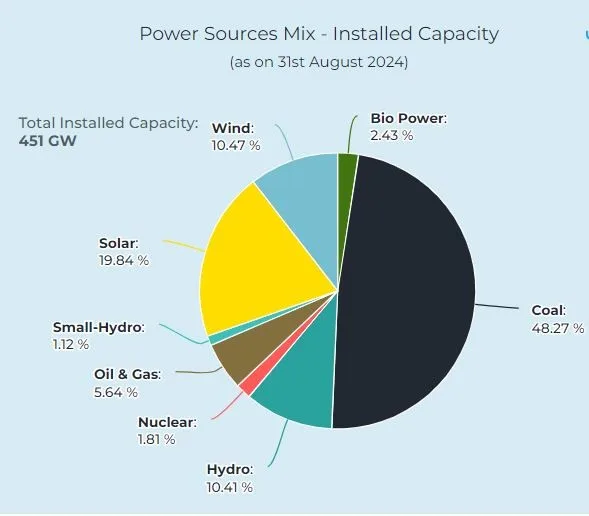Syllabus: GS3/Energy
Context
- The Tamil Nadu government introduced the Tamil Nadu Repowering, Refurbishment, and Life Extension Policy for Wind Power Projects – 2024, aiming to enhance wind energy output by repowering or refurbishing small wind turbines.
- However stakeholders have raised objections to the policy, citing concerns about its effectiveness.
Wind Energy Potential in India
- India has wind power potential for 1,163.86 GW at 150 metres above ground level, and is ranked fourth in the world for installed wind energy capacity.

- Only about 6.5% of this wind potential is used at the national level.
- Gujarat, Tamil Nadu, Karnataka, Maharashtra, Rajasthan, and Andhra Pradesh are the leading States for installed wind energy capacity, collectively contributing 93.37% of the country’s wind power capacity installation.
- As of 2024, renewable energy-based electricity generation capacity stands at 201.45 GW, accounting for 46.3 percent of the country’s total installed capacity.
- Solar power contributes towards 90.76 GW, wind power follows closely with 47.36 GW, hydroelectric power generating 46.92 GW and small hydro power adding 5.07 GW, and biopower, including biomass and biogas energy, adds another 11.32 GW.
India’s Targets
- India has a vision to achieve Net Zero Emissions by 2070, in addition to attaining the short-term targets which include:
- Increasing renewables capacity to 500 GW by 2030, out of which 140 GW will be coming from wind power.
- Meeting 50% of energy requirements from renewables.
- Reducing cumulative emissions by one billion tonnes by 2030, and
- Reducing emissions intensity of India’s gross domestic product (GDP) by 45% by 2030 from 2005 levels.
Challenges
- Dependency on Natural Factors: Energy sources like solar and wind are variable as they rely on natural factors like sunlight, wind and water availability.
- Limited Wind Resource Areas: India’s wind resource potential is largely concentrated in specific regions, such as Tamil Nadu, Gujarat, Maharashtra, and Rajasthan.
- As the wind energy sector expands, land in these regions is becoming increasingly scarce.
- Wildlife Impact: Wind turbines pose a threat to bird and bat populations, which can collide with the blades.
- High Cost: The cost of turbines, installation, and grid connection can be prohibitive, though costs have been declining in recent years.
- Turbine Lifecycle: Wind turbines typically have a lifespan of around 20-25 years.
- Decommissioning and recycling turbine blades, which are made of composite materials, has become a significant concern due to their difficulty in recycling.
- Offshore wind farms are more difficult and expensive to build than onshore ones due to the need for specialized vessels, equipment, and installation techniques.
- These projects are often located in deep waters, requiring floating turbines, which are still in the experimental stages.
Government Initiatives
- National Offshore Wind Energy Policy (2015): This policy was introduced to develop offshore wind energy potential in India, especially along the coastlines of Gujarat, Tamil Nadu, and other maritime regions.
- National Wind Energy Mission: Focuses on the development and expansion of wind energy in India. The target for wind energy capacity is set at 140 GW by 2030.
- National Wind-Solar Hybrid Policy (2018): The main objective of the policy is to provide a framework for promotion of large grid connected wind-solar PV hybrid systems for optimal and efficient utilization of wind and solar resources.
- Wind Resource Assessment: The National Institute of Wind Energy (NIWE) under the Ministry of New and Renewable Energy (MNRE), conducts wind resource assessments to identify potential sites for wind energy generation across the country.
- Wind Farm Development: The program promotes the development of wind power plants by providing financial incentives, including subsidies for setting up wind energy projects in identified areas.
- Wind Energy Auctions (Competitive Bidding): The government conducts competitive auctions where developers submit bids for setting up wind power projects.
- Renewable Purchase Obligation (RPO): This requires power distribution companies and large electricity consumers to procure a certain percentage of their power from renewable sources, encouraging the demand for renewable energy.
Source: TH
Previous article
Adaptation Gap Report 2024
Next article
News In Short 11-11-2024